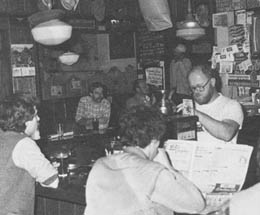Seattle's Blue Moon Tavern first opened its doors at 712 NE 45th Street near the University of Washington on or near April 15, 1934. Founded by Hank Reverman (1912-2009), the tavern was an instant hit with students who, under state law, had to trek one mile from campus to buy a beer. During the 1950s and 1960s, subsequent owners Jack and Jim David and, later, Stanford Poll (1940-2000) welcomed an assortment of radicals, artists, writers, journalists, beatniks, hippies, and wannabees. Poets Theodore Roethke (1901-1963), Richard Hugo (1924-1982), Carolyn Kizer (1924-2014), Stanley Kunitz (1905-2006), and David Wagoner could often be found at the bar, along with famous visitors such as Dylan Thomas (1914-1953) and Allen Ginsberg (1926-1997).
After a long decline in 1970s, the Blue Moon rose anew under management by Three Fools, Inc. In 1989, it was threatened with demolition. Although a popular preservation campaign failed to secure the Moon official landmark status in 1990, developers were persuaded to spare the tavern and it continues to pursue its eccentric orbit to the present day (1999).
Blue Moon Rising
Shortly after the repeal of state and federal laws prohibiting the sale of alcoholic beverages, Henry J. Reverman took his college trust fund and invested to create a new tavern in the shell of a former garage near the corner of 8th Avenue NE and NE 45th Street. Reverman and his partner, Monty Fairchild, dubbed it the "Blue Moon" after purchasing a large neon sign from the nearby Blue Moon Cafe. They opened for business in mid-April 1934.
State law then banned alcohol sales within one mile of the University of Washington Campus, and the Blue Moon lay just over the line. It was an instant success with students, particularly members of the UW football team. Reverman hired local boxers Freddy Steele (1907-1990), Cecil Payne (1906-1959), and "Doc" Snell to keep order.
Monty Fairchild sold his interest in the Moon and founded the Rainbow Tavern just a few doors away. Reverman in turn sold the Moon to Maude Walsh (1906-1968) and Vera McCracken in 1940. (He used the proceeds to found the Lake Union Air Service.) Under the new owners, the Blue Moon was one of the rare bars outside of the Central Area to serve African American servicemen during World War II.
From Beatniks to Hippies
In 1950, brothers Jack and Jim David took over the Blue Moon and welcomed a growing coterie of artists, writers, political radicals, and "beatniks." The tavern's reputation among the avant garde was secured by the frequent patronage of poets Theodore Roethke, Richard Hugo, Carolyn Kizer, and Stanley Kunitz, among others. Dylan Thomas, James Farrell, and Allen Ginzberg (possibly also Jack Kerouac) visited when passing through Seattle. The tavern also provided a haven for UW professors such as Joe Butterworth who were caught up in the McCarthyist purge led by the Canwell Committee.
Jim David sold his share to his brother Jack in 1959. In turn, Jack sold the Blue Moon to Stanford Poll and Dr. Paul Chilton in 1966. They enlarged the tavern to make room for the hordes of hippies and New Leftists who began to supersede the Moon's traditional clientele of beatniks and Old Leftists. The Blue Moon became famous (or infamous) as a clubhouse for Seattle's emerging counterculture. Former Communist Stan Iverson (1927-1985) reigned as its unofficial maitre 'd.
Eclipse and Rebirth
Restaurateur Gerry Kingen attempted in vain to gentrify the Moon in 1970. He sold it to a former bartender, "Fast Eddy" McWhinnie, in 1974. Lack of capital and an increasingly ugly drug scene contributed to the Moon's long descent.
The tavern was rescued from certain eclipse in 1982 by "Three Fools, Inc.," comprising partners Gustav Hellthaler, Robert Morrison Jr. (1948-2008), and John Caldbick. Two years later, in 1984, the Blue Moon was refurbished for its 50th anniversary and won a new generation of customers.
Stan Poll negotiated a long lease that he thought would protect the tavern and sold his interest to Chilton. Clouds appeared in 1989 when Chilton sold the Blue Moon's building to Westlake Capital, which announced plans to replace the tavern with a new retail/condominium project. A spirited public campaign was mounted to block demolition by convincing the City of Seattle's Landmarks Preservation Board to designate the Blue Moon as a cultural landmark. The effort secured broad public and media support, but landmark designation failed on a tie vote on March 7, 1990.
Tavern supporters and neighborhood leaders did not relent, and Westlake Capital principals were genuinely moved by the outpouring of public affection for the Blue Moon. Thanks in large part to the efforts of Hans Aschenbach, president of the Roosevelt Neighborhood Alliance, the parties concluded a settlement on May 4, 1990, scaling back the proposed development and extending the Blue Moon's lease to 2034 -- which, barring disaster, will mark the centennial of its founding.

